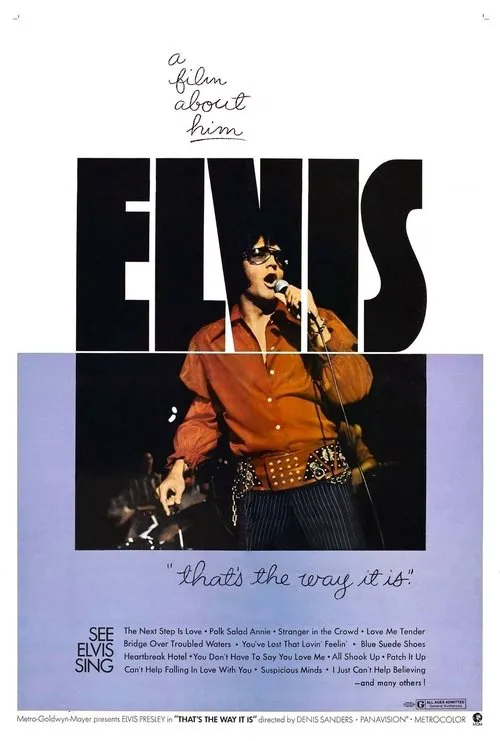Elvis: That's the Way It Is

Plot
Elvis: That's the Way It Is is a 1970 American concert film that captures the performances of Elvis Presley during his residency at the International Hotel in Las Vegas, Nevada, in August 1970. The film is a significant milestone in Elvis's career, marking his triumphant return to the concert stage after an almost decade-long hiatus. Elvis's highly anticipated comeback, which had been building in anticipation, broke all box office records and reestablished him as the undisputed King of Rock 'n' Roll. The film opens with a montage showcasing Elvis's previous performances and recording sessions, which had seen him largely confined to the studio environment. His career had peaked in the late 1950s and early 1960s, but by the late 1960s, he was struggling to find his footing in the rapidly changing music landscape. Despite his commercial success, Elvis had become disillusioned with his creative output, and his live performances had suffered as a result. This period marked a significant low point in his career, with many doubting whether he would ever regain his former glory. However, under the guidance of his manager, Colonel Tom Parker, Elvis began to reassess his priorities and refocus his attention on live performances. The strategy was twofold: first, to recapture the live energy that had defined his early years and second, to rebrand himself as a contemporary artist. In 1970, Elvis embarked on a series of concerts at the International Hotel in Las Vegas, which was a bold experiment, given that he had not performed on stage in almost a decade. The concerts were an overnight sensation, drawing large crowds and delivering scintillating performances that wowed audiences and critics alike. Elvis had clearly rediscovered his mojo, with his energy, charisma, and stage presence on full display. The film captures some of these performances, showcasing Elvis's signature blend of rock 'n' roll, gospel, country, and R&B influences. The setlist is eclectic, featuring a mix of classic hits like "Hound Dog," "Jailhouse Rock," and "Can't Help Falling in Love," as well as recent releases like "Stranger in the Crowd" and "I'll Be There." One of the most notable aspects of the film is the way it humanizes Elvis, presenting a more nuanced and relatable figure than the mythology that had grown around him. Elvis is shown backstage, rehearsing, and preparing for his performances, offering a glimpse into his daily routine and habits. This intimate portrayal adds depth to the film, making Elvis feel more like a person than an icon. The film features footage of Elvis's band, which had undergone significant changes, with guitarist James Burton and pianist Glen D. Hardin becoming key players in his latest lineup. The musical arrangements are more complex and sophisticated than earlier incarnations, reflecting Elvis's growing maturity as an artist. Throughout the film, Elvis's relationships with his band, crew, and family are explored, providing a more personal perspective on his life and career. These interactions reveal a complex, sensitive, and vulnerable individual, far removed from the public image. Elvis's interactions with his musicians, particularly his keyboardist, Glen D. Hardin, showcase his generosity and willingness to engage with others, highlighting the camaraderie that had defined his music in the past. Elvis: That's the Way It Is is a film that celebrates an artist at the peak of his powers, yet still grappling with the demands of his creative output. As he takes the stage, it is clear that Elvis has finally rediscovered his passion for performing, which is contagious and inspiring. The film captures a pivotal moment in Elvis's career, marking the beginning of a new chapter that would see him return to his former glory and push the boundaries of his art. Ultimately, Elvis: That's the Way It Is is a testament to Elvis Presley's enduring legacy as a musician and entertainer. By capturing his performances and private moments, the film provides a rich and nuanced portrait of an artist in transition, demonstrating how he remained committed to his craft and continually pushed himself to new heights.
Reviews
Recommendations




